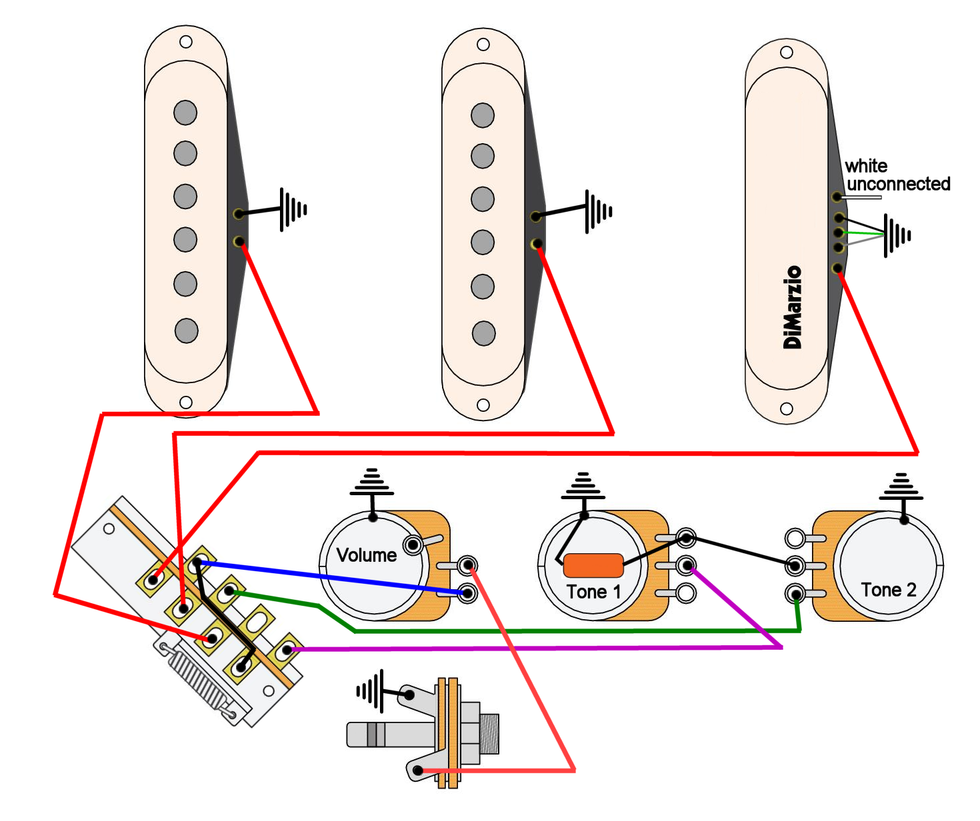Hello, and welcome back to Mod Garage! You’ve probably heard about Eric Johnson’s passion for the smallest and oddest details when it comes to guitars and tone. There is a longstanding urban legend that EJ is able to hear what type of battery is used in his stompboxes and how long his guitar cables are. Regardless of whether or not that’s true, it speaks to his reputation that he really cares about his tone, down to the smallest details.
This month, let’s take a deep dive into the details of Eric Johnson’s 1954 “Virginia” Stratocaster, and discuss how to install its unique wiring scheme in your Stratocaster.
For much of Johnson’s career, he’s played his 1954 Stratocaster, which he nicknamed after a masking-tape label found in the pickup routes. In the ’50s, it was common for employees at the Fender factory to sign the guitars they assembled. This now-iconic instrument was built by an employee named Virginia, one of the earliest women Leo Fender had hired to work at the Fender factory. (Virginia’s last name is a mystery from the early Fender days. There are several photos of her, and other early employees remember Virginia, but none seem to remember her last name.)
In 2020, Fender released the Eric Johnson “Virginia” Stratocaster, as well as a Custom Shop version. It’s unknown when the modifications were done to this guitar. Let’s look at some of the things that make “Virginia” unique, and how you’d recreate this by building your own personal copy:
Body: Two-piece, offset-seam sassafras body painted in the classic Fender two-tone sunburst finish. Sassafras, also called golden elm or cinnamon wood, is native to North America. It’s not a common tonewood, but Fender used sassafras for some early Strat bodies. My guess is that it was used to substitute ash and swamp ash. Sassafras has a grain and appearance similar to ash and chestnut, as well as a similar weight and density, and it was easy and cheap to get in large quantities.
There are different companies offering sassafras Strat bodies, but you can also choose an ash or swamp ash body. If you want to be as close as possible, get a two-piece body. Whether it’s offset-seam or not is up to you.
Neck: One-piece maple neck with a soft V-shape, 12"-radius fretboard sporting 21 jumbo frets and black dots. It should be no problem to find such a Stratocaster neck. And the choice of standard or figured maple is a matter of personal taste.
Hardware: Basically the standard Fender hardware from the ’50s, such as the typical Fender ’50s Stratocaster tremolo and Kluson vintage tuners. Here is a list of what is not standard on this guitar’s hardware:
- A single Graph Tech String Saver saddle is used on the high E string. All the other saddles are ’50s standard bent-steel saddles.
- A flat washer on the output jack.
- The tremolo uses four springs (instead of five), and the one that’s under the B string is not installed.
- A single ’60s-style butterfly string tree with a nylon spacer underneath, instead of the ’50s-style round string tree
The plastic parts: This is also ’50s standard, sporting a single-ply offset-white pickguard with aged-white pickup covers, knobs, switch tip, and tremolo arm tip.
EJ plays pure nickel strings, so this is also recommended if you want to get as close as possible.
Now, let’s have a close look at the electronics and wiring. Here is a list of the electronic parts you’ll need:
- DiMarzio DP116 HS-2 stacked humbucker bridge pickup
- Fender ’57 or ’62 EJ middle and neck pickups
- Standard open-blade 5-way pickup selector switch
- Cloth wire for all connections
- 375k audio volume pot with a 90/10 taper ratio, no treble-bleed network
- Two 250k audio tone pots with a 90/10 taper ratio
- 0.1 μF/150 V wax-paper tone capacitor
- Standard mono output jack
Getting all these parts should be no problem at all. The pickups are in production, 375k pots are available from various companies, and new wax-paper capacitors are also available. All three pickups should use latex tubing instead of springs for pickup-height adjustment.
If you wish to use NOS wax-paper caps, don’t worry about the voltage. It will have absolutely no influence on the tone inside the guitar, only on its size. Be sure its capacitance is close to 0.1 μF, because these caps have a tendency to drift in capacitance over time.
The switching matrix is almost standard Stratocaster and goes like this:
#1: bridge pickup
#2: bridge + middle pickup in parallel (in phase)
#3: middle pickup
#4: middle + neck pickup in parallel (out of phase)
#5: neck pickup
The DiMarzio stacked humbucker is permanently used as a split single-coil pickup with only the upper spool being engaged, so no humbucking feature is activated. The upper tone control is assigned to the neck pickup, while the lower tone control is connected to the bridge pickup, leaving the middle pickup without tone control. The pickguard uses ’50s-style copper-foil shielding (connected to ground), but only under the area where the electronics are installed, not over the whole pickguard.
If you want to put this wiring into your Strat, take notice of the out-of-phase feature in switching position #4. On the “Virginia” Strat, the bridge pickup has a south polarity, while the middle and neck pickups both have a north polarity, and the middle pickup is reverse-wound. Please note that this is not a reverse-wound, reverse-polarity (RWRP) pickup, because both pickups need to have the same magnetic polarity. There are many pickup combinations where this feature will not work, so upgrading your pickups may be necessary if you want the full package. In short, you need a middle and neck pickup with the same magnetic polarity, one of them reverse-wound, and both in phase with the bridge pickup.
So, here we go for the wiring (Fig. 1). As always, I tried to keep it as clean as possible by substituting the ground-wire runs with the international symbol for ground. I used the DiMarzio humbucker color code for the bridge pickup. If you decide to use a different brand, you need to transfer the color code of the wires with the correct color-code chart.
That’s it. Next month, we will dissect the new Fender John 5 “Ghost Telecaster” wiring, so stay tuned.
Until then ... keep on modding!

















![Rig Rundown: Russian Circles’ Mike Sullivan [2025]](https://www.premierguitar.com/media-library/youtube.jpg?id=62303631&width=1245&height=700&quality=70&coordinates=0%2C0%2C0%2C0)


























